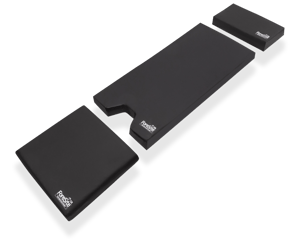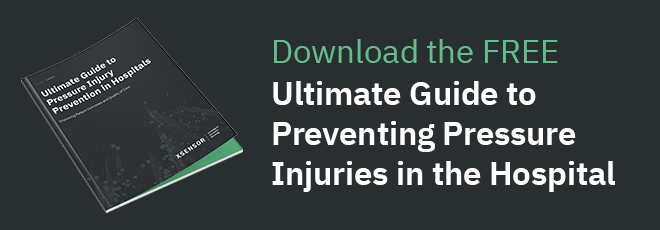
How to Choose the Best Pressure Sore Mattress
Since pressure injuries often originate in hospital beds, pressure sore mattresses are an important part of the solution.
The significance of pressure injuries obtained in hospitals is not lost on medical professionals. When left untreated, late-stage pressure sores, also known as bed sores, have serious health implications for patients—even causing death in some instances. Standard prevention and treatment methods are effective, but require manual labor and valuable time on the part of health teams, so approaching this issue with both patient safety and staff efficiency in mind is essential.
In the United States alone, 2.5 million pressure injuries are developed yearly, with 60,000 of them becoming fatal. Since pressure injuries cause challenges for staff and patients alike, institutions should consider solutions that stand to improve patient care and workload management.
Multiple solutions and technologies exist to prevent pressure injuries from developing—the matter is implementing the right ones. When used in conjunction with proven treatment plans and wound care strategies, the integration of pressure sensing technology equips health teams to allocate appropriate care and attention where and when it is most needed—ultimately serving to raise standards of care across the institution.
Pressure Sores: The 4 Stages of Development
Pressure sore development is classified into four main stages of injury to the skin. Any injury—regardless of its stage—needs to be treated with urgency, using strategies and technology that prevent the sore from advancing quickly.
Here are the four stages and the types of pressure sores, from early skin damage to serious ulcer progression.
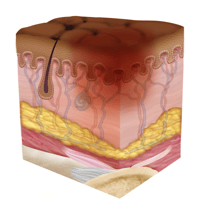 Stage 1 Pressure Injuries and Ulcers: Early on in pressure ulcer development, the skin is developing injury. While no open sores or broken skin is present yet, skin may appear redder, warmer or firmer than usual. Known as a non-blanchable erythema of intact skin, the color change may even indicate the beginnings of a serious injury to the deep tissue.
Stage 1 Pressure Injuries and Ulcers: Early on in pressure ulcer development, the skin is developing injury. While no open sores or broken skin is present yet, skin may appear redder, warmer or firmer than usual. Known as a non-blanchable erythema of intact skin, the color change may even indicate the beginnings of a serious injury to the deep tissue.
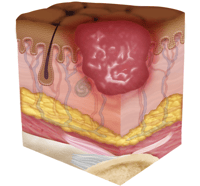 Stage 2 Pressure Injuries and Ulcers: Stage 2 pressure sore development is where the true sore, or ulcer, develops as a break in the skin. This is often very painful, and can create serious damage within the skin. Known as partial-thickness skin loss with exposed dermis, these bed wounds can quickly become something worse.
Stage 2 Pressure Injuries and Ulcers: Stage 2 pressure sore development is where the true sore, or ulcer, develops as a break in the skin. This is often very painful, and can create serious damage within the skin. Known as partial-thickness skin loss with exposed dermis, these bed wounds can quickly become something worse.
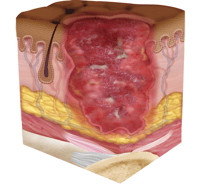 Stage 3 Pressure Injuries and Ulcers: In this stage, the pressure ulcer has developed into the soft tissue underneath the skin. Known as full-thickness skin loss, this pressure sore stage may showcase a deep wound, especially in an area with more adipose tissue.
Stage 3 Pressure Injuries and Ulcers: In this stage, the pressure ulcer has developed into the soft tissue underneath the skin. Known as full-thickness skin loss, this pressure sore stage may showcase a deep wound, especially in an area with more adipose tissue.
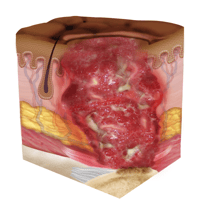 Stage 4 Pressure Injuries and Ulcers: By the final and most serious stage of a pressure sore, the skin may have receded into the muscle tissue or the bone, causing lasting damage to the skin and underlying areas. Known as full-thickness skin and tissue loss, this pressure sore stage can show visible or palpable fascia, bone, muscle or tendon.
Stage 4 Pressure Injuries and Ulcers: By the final and most serious stage of a pressure sore, the skin may have receded into the muscle tissue or the bone, causing lasting damage to the skin and underlying areas. Known as full-thickness skin and tissue loss, this pressure sore stage can show visible or palpable fascia, bone, muscle or tendon.
Choosing the Right Pressure Sore Mattress
Pressure sore mattresses can be an incredibly helpful, and necessary, tool for patients needing to stay confined to bed for long periods of time. These are particularly crucial for longer-term hospital stays, especially for pressure reduction among patients who already have high risk factors for pressure injury development.
Mattresses to Relieve Pressure Sores
When choosing pressure sore mattresses, there are two main categories: 1) mattresses, and 2) smart mattress pads. When it comes to mattress pads, choosing one outfitted with a bubble-style topper that allows for even weight distribution is wise. By integrating these types of mattress overlays into patient care, you decrease the likelihood of a pressure sore developing in the first place during the patient’s time in bed.
For mattresses, multiple options exist that help to prevent pressure sores, using a variety of methods.
- Foam mattresses or gel mattresses help prevent shear, by moving with the patient and relieving pressure points. These work by distributing pressure over a larger area and are best for mobile patients.
- Air-filled mattresses (also known as alternating air mattresses) deflate and inflate in different positions against the patient’s skin with an air cell that offers movement.
- Lateral rotation mattresses can assist in turning an immobile patient.
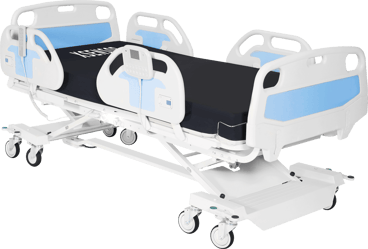
XSENSOR offers an intelligent surface overlay as well as its own pressure sore mattress—the ForeSite Intelligence Surface—which integrates AI-powered technology within the mattress itself, equipping hospital staff with real-time data that allows them to individualize care plans for each of their patients.
Each mattress features a sensor-enabled redistributing surface, using technology that includes more than 1,500 undetectable sensors. The overlay with the same sensing layer is compatible with any hospital mattress. The viewer software displays real-time pressure images and automatic alerts notify clinicians of key information. A cloud database is used to display data, and an optional microclimate layer may be added to manage moisture. XSENSOR’s continuous bed monitoring technology is an innovative solution for preventing and managing pressure injury development.
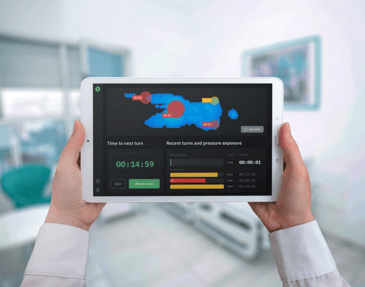 XSENSOR’s Pressure Injury Solution Technology
XSENSOR’s Pressure Injury Solution Technology
Along with mattresses, health care professionals can rely on XSENSOR for solutions that run the entire healthcare gamut. Whether on beds, surgical tables or wheelchairs, XSENSOR technology assists in alleviating staff workloads and elevating patient care.
- For hospital beds: Our unique ForeSite Intelligent Surface mattress system uses more than 1500 sensor cells on the surface of a mattress or fitted cover to measure patient body surface pressures, displaying data in real time for continuous monitoring. The system includes a turn clock to track repositioning and informs better patient care. Powered by AI, our support surfaces use technology that helps redistribute pressure and allows tissues to reoxygenate.
- For surgical tables: Our ForeSite OR system carries the same technology through to the operating room, which is excellent for ensuring safe positioning and managing risk in longer surgeries. ForeSite OR's integrated sensing layer helps clinicians redistribute pressure to support skin and reduce risk.
- For wheelchairs: Our ForeSite SS system utilizes high resolution sensing for those in wheelchairs. Since wheelchair patients can be very susceptible to tissue damage, the ForeSite SS system uses sensing, high-resolution images and software to show clinicians the necessary data.
At XSENSOR, our goal is to provide technology and solutions that help both patients and staff. Pressure injury management plays a significant role in the day-to-day work of health teams worldwide. Pressure sore mattresses are an important component of that work, and our continuous bed monitoring technology offers a superior option for hospitals looking to improve their standards of care. Contact us today.
Pressure injury schematic drawings courtesy of The National Pressure Injury Advisory Panel. https://npiap.com/page/PressureInjuryStages

